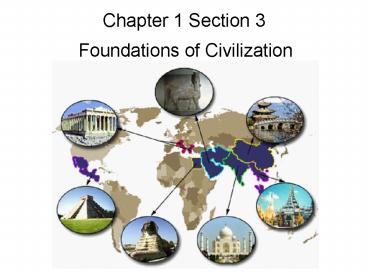Chapter 1 Section 3 - PowerPoint PPT Presentation
1 / 20
Title:
Chapter 1 Section 3
Description:
Chapter 1 Section 3 Foundations of Civilization The Main Idea From farming villages arose cities, and with them, the first civilizations, marking the beginnings of ... – PowerPoint PPT presentation
Number of Views:158
Avg rating:3.0/5.0
Title: Chapter 1 Section 3
1
Chapter 1 Section 3
- Foundations of Civilization
2
- The Main Idea
- From farming villages arose cities, and with
them, the first civilizations, marking the
beginnings of recorded history. - Focus
- Why did some villages develop into cities?
- What characterized the worlds first
- civilizations, and where did they develop?
- What factors cause civilizations to change
- over time?
3
I. From Villages to Cities
Villages grew and the first cities appeared
City of Uruk, c. 3000 BC
4
I. From Villages to Cities
- Improved agriculture and irrigation resulted in
- a food surplus
Shadouf Irrigation
5
I. From Villages to Cities
- Fewer people needed to farm others worked
- in different tasks division of labor
Egyptians artisans smelted copper and gold for
artistic, architectural, and military purposes.
6
I. From Villages to Cities
- Cities larger/more densely populated
- First known city - Uruk
Uruk, 3000 BC Population 40,000 to
50,000 Size 1000 acres
7
I. From Villages to Cities
- City populations more diverse
- Village - families/clans traditional economy
- City - unrelated people complex economy
8
I. From Villages to Cities
- Formal organization in cities
- Centers of trade
Ancient Babylon, c. 600 BC
9
II. The First Civilizations
10
II. The First Civilizations
- Civilizations - complex organized cultures
- with common characteristics
11
Characteristics of Early Civilizations
- Developed Cities political, economic, and
cultural centers - Organized Government laws/systems of justice,
food production, taxation
Harappa, Indus River Valley
12
Characteristics of Early Civilizations
- Formalized religion priests, ceremonies,
rituals - Government and religion closely connected
Egyptians saw their pharaoh as a god, more
specifically as the god Horus Egyptian Gods
Horus and Osiris and Pharaoh Seti I
13
Characteristics of Early Civilizations
- Specialization of labor farmers, soldiers,
artisans, merchants, etc.
The earliest specializations were baking,
brewing, weaving, dyeing, carpentry,
pottery-making, stone and metal-working
merchants, soldiers and artists priests and
healers temple managers, bureaucrats,
calendar-keepers, and scribes
14
Characteristics of Early Civilizations
- Social classes - People became ranked according
to job, wealth, or influence
15
Characteristics of Early Civilizations
- Abstract writing for record keeping
- Calendars to keep track of yearly events
Cuneiform tablet
16
Characteristics of Early Civilizations
- Arts and architecture reflected beliefs, values,
strength, and culture
Mesopotamian Ziggurat
Temple of Hephaistos
17
III. Changes in Civilizations
- Civilizations changed over time some failed,
others succeeded and grew
18
III. Changes in Civilizations
- Forces of nature
- Need for resources
- Expanded trade for scarce resources
Salt mine in the Sahara Desert
19
III. Changes in Civilizations
- Cultural Diffusion - spread of ideas, customs,
- culture, and technology by migration, trade,
- warfare
Traders approaching Timbuktu in Mali
Diffusion of language
20
III. Changes in Civilizations
- Warfare brought change victors forced way
- of life upon defeated































